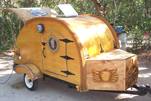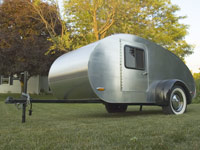Glues, Screws and Sealnt questions.
13 posts
• Page 1 of 1
Glues, Screws and Sealnt questions.
I've got my sidewalls cut out and ready to begin framing for a sandwich wall. I've got questions I can't find answers to with the search function. I understand that walls should be sealed inside and out. I'm using titebond III. I read that sealant should be applied everywhere except where it will be glued. However, I also read that the 3/4" insulation I'm using should be glued to the wood so as to become part of the stuctural element. So how do I reconcile these two opinions? Should I cover everything with the Titebond? Use a particular sealer? Also, when gluing the bracing, should I screw thru the outside of the wall into it for a stronger structural unit or just trust the glue? Thanks for any advice.
- mufb
- Donating Member
- Posts: 25
- Images: 10
- Joined: Thu Jun 15, 2006 3:45 pm
- Location: WI
If you're doing sandwich walls, you don't have to glue the insulation in. Just wedge it in there.
If you're using 3/4 insulation, you'll be using 1 by 2s for your framing, which when positioned right, actually measures 3/4" deep--perfect for your insulation to go in there, and then to place your interior wall/skin.
Also, what dimension material are you using for your interior wall? You don't have to go overboard here--1/4" is more than enough. You can probably get away with 1/8". (Note that some people don't even PUT an interior wall in; they just frame, no insulation.)
Also, I just sealed my exterior walls with Thompson's deck sealer. (I just edited this post because I just REMEMBERED that I did this. It's been so LONG!)
If you're using 3/4 insulation, you'll be using 1 by 2s for your framing, which when positioned right, actually measures 3/4" deep--perfect for your insulation to go in there, and then to place your interior wall/skin.
Also, what dimension material are you using for your interior wall? You don't have to go overboard here--1/4" is more than enough. You can probably get away with 1/8". (Note that some people don't even PUT an interior wall in; they just frame, no insulation.)
Also, I just sealed my exterior walls with Thompson's deck sealer. (I just edited this post because I just REMEMBERED that I did this. It's been so LONG!)
Last edited by Ira on Wed Oct 25, 2006 8:10 am, edited 1 time in total.
Here we go again!
-

Ira - Forum Storyteller
- Posts: 5652
- Images: 118
- Joined: Tue Nov 29, 2005 2:16 pm
- Location: South Florida


 I'm thinking of building a teardrop, so at this point I'm a backseat sawdust maker. Here's how I intend to seal the frame and insides of the sandwich construction walls and roof of my (future) teardrop. There will be unsealed wood to wood areas to hold glue between the frame and the skins with this method. (edited 10/31/06)
I'm thinking of building a teardrop, so at this point I'm a backseat sawdust maker. Here's how I intend to seal the frame and insides of the sandwich construction walls and roof of my (future) teardrop. There will be unsealed wood to wood areas to hold glue between the frame and the skins with this method. (edited 10/31/06)
 Drink your favorite beverage.
Drink your favorite beverage.

